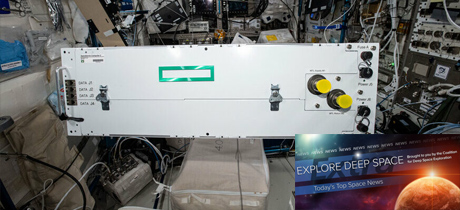In Today’s Deep Space Extra… The Spaceborne Computer-2 program completes first round of experiments aboard the International Space Station. South Korea praises Artemis Accords.
Human Space Exploration
Spaceborne Computer-2 shows results on Space Station
SpaceNews.com (8/18): A joint Hewlett Packard Enterprises and Microsoft experiment aboard the International Space Station (ISS), the HPE Spaceborne Computer-2, has demonstrated the value of processing data on the orbital space lab and placing it in the cloud rather than transmitting the data to ground for processing. Four experiments in the fields of quantum computing, security, healthcare, and life sciences have been carried out since February. Twenty-nine and potentially more await trials in the coming two to three years. The technology is anticipated to be of benefit to remote areas on the Earth as well.
Chinese astronauts to conduct extravehicular activities for second time
Xinhuanet of China (8/17): Astronauts aboard China’s new space station are expected to carry out a second spacewalk within a few days. The three astronauts arrived on June 17 as part of China’s seventh crewed space mission, and its first in nearly five years. (Editor’s note: Xinhuanet is a Chinese government-owned news source).
Space Science
BepiColombo spacecraft records the sound of solar wind at Venus
Space.com (8/19): The Mercury-bound BepiColombo spacecraft listened to the sound of the solar wind at Venus as it flew just 340 miles above the planet’s surface during a maneuver designed to adjust its path. BepiColombo, a joint mission by the European Space Agency (ESA) and the Japan Aerospace Exploration Agency (JAXA), recorded the audio with its magnetometer, providing a rare glimpse into the interaction between the stream of charged particles flowing from the sun, known as solar wind, and the thick carbon dioxide-rich atmosphere of Earth’s closest planetary neighbor. The audio is not the actual sound that could be heard in space but a so-called sonification, a translation of data into sounds, ESA said in a statement.
Lunar landing site of UAE’s Rashid rover revealed
The National (8/19): The Arab world’s first lunar rover, Rashid, will land on the north-eastern part of the Moon’s near side, on a site known as the Lacus Somniorum. “This is a place that was selected for two purposes – safety and science. Lunar missions always have areas that would be safe for landing, where you could avoid obstacles,” said Dr. Hamad Al Marzooqi, project manager of the Emirates Lunar Mission. Marzooqi added that a launch window had been set for next year between August and December.
Other News
SpaceX Starlink satellites responsible for over half of close encounters in orbit, scientist says
Space.com (8/18): According to Hugh Lewis, the head of the Astronautics Research Group at the University of Southampton, U.K., the hundreds of Starlink satellites that SpaceX has launched to extend its communications network are involved in about 1,600 close encounters between space objects each week.
South Korea touts Artemis Accords as a way to settle international space issues
SpaceNews.com (8/19): In May, South Korea became a signatory to NASA’s Artemis Accords. At the recent Space Diplomacy Forum 2021, the country’s Vice Foreign Minister Choi Jong-moon praised the potential for the Accords to reduce conflict as more nations and their citizens become spacefaring. “Such challenges cannot be addressed by any one country alone, which prompts us to think that international cooperation through diplomacy will be of redoubled significance in the coming era,” said Choi.
South Korea’s Satrec Initiative to build constellation of high-resolution Earth observation satellites
SpaceNews.com (8/18): South Korea’s Satrec Initiative plans to place a high-resolution imaging satellite called SpaceEye-T into low Earth orbit by the first quarter of 2024. The launch is to initiate a constellation of Earth observation satellites for military and civilian customers in South Korea and abroad.
Chang Zheng-4B launches with two Tianhui 2 satellites
NASAspaceflight.com (8/19): China on Wednesday launched a second group of Tianhui 2 Earth observation satellites aboard a Long March 4B rocket. Like the first group launched in late April, the second was placed in a high inclined orbit.
Aerojet Rocketdyne expands Los Angeles Facility for NASA’s Moon and Mars rocket
Coalition Member in the News – Aerojet Rocketdyne
Globe Newswire (8/19): Aerojet Rocketdyne has finished an expansion of its Los Angeles facility to support production of new-generation RS-25 main engines for NASA’s Space Launch System (SLS). “This expanded facility will serve NASA’s human exploration requirements for decades to come,” said Eileen P. Drake, Aerojet Rocketdyne CEO and president.

